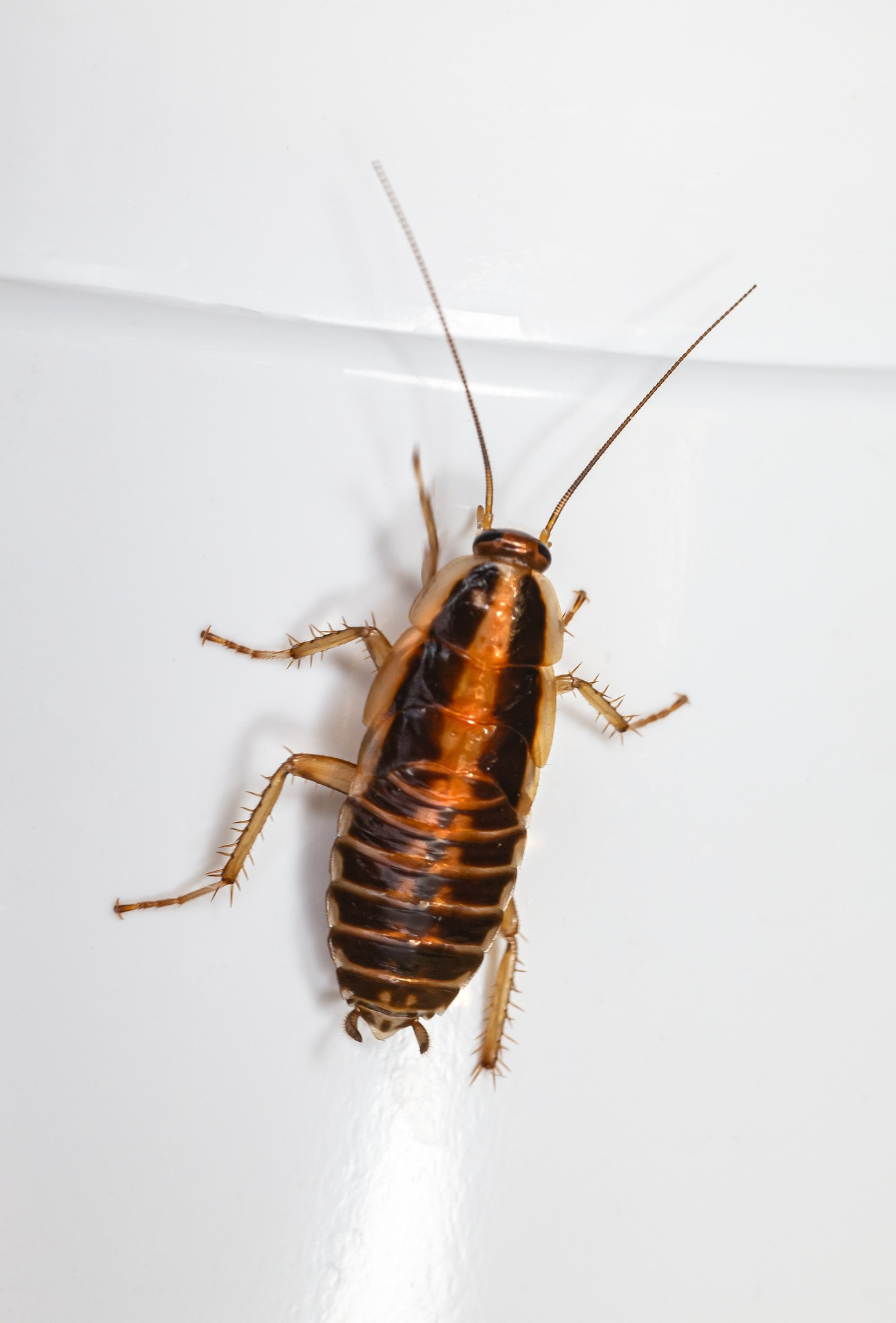While German cockroaches may not be as big as an Oriental cockroach, they can spread much faster. Just one female German cockroach can produce hundreds of offspring in a single year.
Chances are, if you find one German cockroach in your home, there are dozens, if not hundreds more, lurking.
We’ve laid out step-by-step instructions to help you get rid of German cockroaches quickly and prevent them from returning.
What Do German Cockroaches Look Like?
The first step of proper cockroach control is to identify an infestation.
German cockroaches are smaller than some of the other cockroaches in Maryland; they are only about 1/2 to 5/8 of an inch long. However, like other roaches, they have six legs, long antennae, and a set of long wings that start at the rear of the head and cover their entire backs.
However, what distinguishes a German cockroach from the Oriental is the pair of nearly parallel dark stripes that runs down its head. These stripes stand out against their light brown to tan bodies and make them easy to identify.
What Diseases Do German Cockroaches Spread?
Sure, German cockroaches are nasty creatures, but they also are vectors for disease and bacteria.
German cockroaches love to live in warm, moist places, and they’re not at all picky about where they set up shop. So anything from a sewer to a compost pile can make an attractive hangout spot for roaches.
When they finally end up in your home, they can bring all sorts of pathogenic stowaways. For example, German cockroaches spread everything from salmonella to E. coli to dysentery and possibly even bubonic plague. All in all, these roaches are known or suspected to spread over 40 different kinds of viruses, bacteria, parasites, and other pathogens.
What’s worse is German cockroaches are often a lot more severe than other roach infestations. Everyone knows the old euphemism, “For every roach you see, there are fifty you don’t,” and that goes double for the German cockroach.
Unlike American cockroaches (also commonly called palmetto bugs), German cockroaches like to live indoors rather than outside. Unfortunately, they also breed faster than many other roach species, meaning one or two individuals can quickly balloon into a massive infestation.
What Are Signs Of German Cockroaches?
Since German cockroaches are good at scurrying out of sight, you might not see a live roach even if you have a severe problem.
German cockroaches desire warm and moist environments with easy access to food and hiding places. That means they’re most likely to be found in your kitchen, but they can also be found in bathrooms, basements, crawlspaces, etc.
Look for signs of a German cockroach infestation, such as:
- Roach droppings that look like fine coffee grounds.
- Egg capsules that shed and peel apart.
- Smear marks left by roaches crawling through water.
- A foul or musty odor that you can’t identify.
- Live cockroach activity during the day.
Once you identify the signs of an infestation, it’s time to get to work in putting it down.
Steps to Get Rid of a German Cockroach Infestation
Step 1: Clean Your Home
The first step to treating any pest infestation is to get rid of their food source. Eliminate all trash and clutter by vacuuming up hard-to-reach corners in your house and taking care of any dirty or wet spots.
Reduce moisture content with a dehumidifier and vacuum up any standing water in your house.
Cleaning your house will also make any baits or traps you lay out more effective.
Step 2: Use Baits and Gels
Baits can sometimes be effective, though it’s recommended you skip step two and go straight to a professional. Regardless, some bait stations may be effective against small infestations.
Bait traps and gels carry a poison that gets carried through cockroach populations and slowly stops them from breeding.
Baits are recommended over sprays which don’t kill cockroaches as effectively and only drive them into deeper recesses in your home.
Step 3: Call a Professional Exterminator
Unfortunately, roaches’ ability to withstand just about any catastrophe isn’t all that exaggerated. By the time sticky traps catch them, they’ve likely already replaced themselves a hundred times over. Even worse, they’re resistant to a lot of poisons and chemical pesticides. That’s why you’ll need professional help to deal with a German cockroach infestation.
A professional exterminator can conduct an inspection to identify the extent of your problem and create solutions to quickly eradicate any roach presence from your home. The price of pest control may seem steep, but the faster you deal with an infestation, the more affordable it becomes.
Most exterminators have proper experience handling chemicals and can even use integrated pest management tactics that are safe and effective.
Step 4: Prevent German Cockroaches from Returning
Once a German cockroach infestation has been eliminated, it’s keen to prevent these pests from returning.
Some German cockroach prevention tips we recommend include:
- Conducting regular inspections with a qualified professional
- Reducing the amount of clutter and trash around your home
- Only eating in one room of the house
- Storing all food in airtight containers
- Reducing moisture and humidity in your home
- Sealing all gaps and cracks where cockroaches enter
- Keep compost piles and yard clutter far away from your home
- Conducting thorough cleanings of your basement, attic, and crawl spaces
When dealing with a cockroach infestation is too much, don’t hesitate to reach out to a cockroach control expert.
Here at Pest Czar, customer satisfaction is our #1 goal. Therefore, we offer eco-friendly treatment options at affordable prices, free re-services as necessary, and cockroach control plans tailored to your needs rather than our sales goals. So call us at (855) 273-0517 or visit our contact page to schedule your inspection today!


